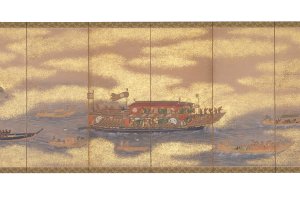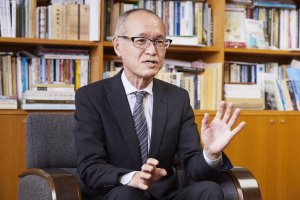From April 13 to Oct 13, 2025, Osaka will host the Expo 2025 Osaka, Kansai, Japan (hereinafter Expo 2025 Osaka).
This global event is estimated to attract approximately 28.2 million visitors, shining a light on Osaka City as a destination. Typically, tourists associate Osaka with its renowned gastronomy, its lively city vibes, and even Universal Studios Japan (USJ). However, the city’s legacy extends far beyond these notable points. In order to fully share Osaka’s heritage with future travelers, six museums in Osaka will host a promotional campaign called the “OSAKA-HAKU” in conjunction with the Expo 2025 Osaka.
What is the OSAKA-HAKU?
The OSAKA-HAKU is a campaign that aims to broaden visitors’ perspectives of Osaka by disseminating information about Osaka tourism and the city’s museum culture. The central focus of the OSAKA-HAKU will be a web exhibition. During this exhibition, each museum will showcase a “Treasure of Osaka” hand-selected by directors at the respective facilities. Together, these pieces relate to nature, history, art, and science—perfectly embodying Osaka’s diverse charms.
Osaka’s museums and the “Treasures of Osaka”
In tandem with the Expo 2025 Osaka, the city’s museums serve as excellent ways to further enrich your Osaka experience. Many of the museums are located in close proximity to one another—spanning the Nakanoshima, Osaka Castle, Tennoji, and Nagai Park areas—and thus, are ideal for museum-hopping!
Read on to discover the city’s exceptional museums and their corresponding Treasures of Osaka.
1. Cretaceous Ammonites @ Osaka Museum of Natural History

First, let’s visit the Earth’s long distant past at The Osaka Museum of Natural History, where its director, Kiyoshi Kawabata, selected Cretaceous Ammonite as the museum’s Treasure of Osaka. Ammonites are shelled, ocean-dwelling cephalopods that went extinct 66 million years ago. Many of the museum’s ammonites and fossils were found in Izumi Mountains, located in the southern part of Osaka Prefecture, making them especially important to the facility. You can view the ammonites in Exhibition Hall 2 (History of the Earth and Life) and Exhibition Hall “Nature Square.”
The museum

The Osaka Museum of Natural History, located near Nagai Park and teamLab’s Nagai Botanical Garden, is an engaging facility that guides visitors through the plants, animals, and natural history of Osaka. Instead of solely focusing on nature, the museum prioritizes the theme of “human and nature” to convey how human actions influence the environment. Following the past to the present, the museum covers all forms of Osaka’s nature, from its mountains and rivers to its urban parks and even residents’ homes. The museum’s vision is to have people visit the museum, learn about Osaka’s rich biodiversity, explore nature firsthand, and then return to the museum with questions inspired by their journeys. For inbound tourists, where returning to the museum may not be feasible, the facility hopes that the exhibits inspire them to compare Osaka’s nature to that of their home country. These experiences help people gain a deeper appreciation for nature and can encourage them to seek ways to maintain its beauty.
The museum has pamphlets in English, Korean, Simplified Chinese, and Traditional Chinese and translates its main exhibition panels in the same four languages. However, specific descriptions are only in Japanese. Since the museum has Wi-Fi, we recommend that you use a translation tool on your phone.
2. Painting of Ships for Korean Envoys @ Osaka Museum of History

The Osaka Museum of History’s Treasure of Osaka is a painted folding screen that depicts Korean envoys sailing to Japan—with Osaka as a stopping point—for diplomatic relations during the 17th to early 19th century. This interaction was a rare and special occasion as it took place during the Edo Period (1603-1868) when Japan closed itself off from the world. In 2017, this artwork was selected as a UNESCO Memory of the World. Aside from its uniqueness, the museum’s director, Kenichi Osawa, chose this artwork as a symbol for present and future generations. Even if neighboring countries have tense relations, they can cooperate if people put in the effort to do so. While the museum does not always display this artwork, it will be available to the public during the period of the Expo 2025 Osaka.
The museum

Situated adjacent to Osaka Castle, Osaka Museum of History is a 13-floor facility that utilizes life-sized models and miniatures to immerse visitors in Osaka’s history, from ancient times to the modern age. Here, guests can mainly observe exhibits that encompass everything from 7th-century archeological artifacts to city life in the 1920s and 1930s! Given its close proximity to Osaka Castle and the ruins of Naniwa-no-miya—a 7th-century palace during Osaka’s time as Japan’s capital—the museum is an ideal starting point for historical exploration.
Additionally, the museum offers excellent views of Osaka Castle and is only one train station away (without changing trains) from the Expo 2025 Osaka’s location. Osawa hopes that when people visit the museum they will leave with an even greater interest in Osaka and Japanese history.
The museum has pamphlets in English, Korean, Chinese, Spanish, Arabic, French, and Thai and is currently preparing audio guides in foreign languages. While some exhibit descriptions are in English, many are only in Japanese. However, given the facility’s emphasis on visual displays, visitors can still learn a lot about Osaka’s history despite any language barriers.
If you are planning to visit Osaka Castle and the Osaka Museum of History, you can buy a bundled discount ticket for ¥1,000 at either facility.
3. Giant Torayan @ Nakanoshima Museum of Art, Osaka

The museum’s director, Tomio Sugaya, selected the sculpture Giant Torayan as the facility’s Treasure of Osaka. Created by Osaka-born artist Kenji Yanobe, the Giant Torayan is a 7.2-meter tall robot sculpture that acts as a guardian deity for children. At the heart of the sculpture is a ventriloquist doll called Torayan that belonged to the artist’s father. This sculpture is one of Yanobe’s largest works and is located in the fourth floor’s passage. Yanobe also created a spacesuit-wearing cat sculpture titled SHIP'S CAT (Muse), located in the museum’s grassy area, which visitors can view for free.
The museum

The Nakanoshima Museum of Art, Osaka, newly opened in February 2022, is a modern and contemporary art museum located in Osaka’s trendy Nakanoshima area. This eye-catching facility boasts a chic exterior and features a spacious, nature-entwined layout perfect for artistic exploration. The museum has an extensive collection of over 6,000 Japanese and international art and design pieces and primarily displays them in temporary exhibitions. By focusing on the special exhibitions, which contain a mix of loaned artworks and the museum’s own pieces, the facility aims to garner heightened intrigue for the selected works. Typically, the museum has eight special exhibitions each year on its fourth and fifth floors.
4. View of Jiangshan Tower @ Osaka City Museum of Art

For the Osaka City Museum of Art's Treasure of Osaka, museum director, Sakae Naito, selected View of Jiangshan Tower, a Northern Song Dynasty (960–1127) landscape painting by renowned court painter, Yan Wengui. Since there are very few original artworks left from this era, Naito believes that the painting is not only a Treasure of Osaka, but a treasure of the world. The surprisingly small—only 30cm tall—painting is abundant in minuscule details, including people and boats interwoven into intricate sceneries. In fact, to fully appreciate the masterful artistry, Naito recommends that you bring a monocular! To preserve the painting, the museum only displays it for a short period of time annually, so you will not want to miss its presentation during the Osaka Expo.
The museum (reopening spring 2025)

The Osaka City Museum of Art is located in the heart of Tennoji Park and thus, is an excellent spot to pair with a relaxing day in Osaka’s urban nature. The museum has a vast collection of over 8,500 art pieces—including paintings, sculptures, and craftworks—from Japan, China, and other Asian countries. The museum’s most popular displayed works are its Chinese sculptures and paintings, as well as its Inro (suitcases) and netsuke, which are carved stoppers attached to small containers via cords that people hang from their obi (kimono sash) to carry personal belongings. Visitors are often surprised by how detailed the netsuke are despite their small sizes. Aside from its collections, the museum itself is the third oldest public art museum in Japan and its main building, built in 1936, is listed as a cultural property.
Although presently closed, the museum plans to reopen in the spring of 2025. With its renewal, the museum will enhance and design its permanent exhibitions so foreigners can enjoy them anytime, add a permanent room for its collection of Chinese Buddhist statuess, add a room for the aforementioned Inro (suitcases) and netsuke, create a digital archive where people can view its main exhibition pieces online, and more.
With its reopening, the museum also aims to strengthen Wi-Fi access throughout its facilities so guests can use their smartphones to translate descriptions and other content.
5. Oil-drop Tea Bowl @ The Museum of Oriental Ceramics, Osaka

If you are a tea lover, ceramic connoisseur, or someone who simply enjoys looking at unique pieces, you will not want to pass over The Museum of Oriental Ceramics, Osaka. The museum’s Treasure of Osaka, selected by the museum director, Masashi Moriya, is an Oil-drop Tea Bowl produced at the renowned Jian Kiln in China’s Fujian Province during the Southern Song Dynasty (1127–1279). This Oil-drop Tea Bowl is designated as a Japanese National Treasure and once belonged to Toyotomi Hidetsugu, who was the nephew of Toyotomi Hideyoshi, one of the great unifiers of Japan. The tea bowl is classified as a yuteki tenmoku, which is the second highest grade of tenmoku tea bowls. Presently, Japan has about 10 yuteki tenmoku, and the museum’s one is regarded as the country’s most beautiful. Many people say that the dish’s golden and silvery-white flecks against the bluish-black glazed surface tinted with iridescence is reminiscent of the cosmos. You will likely find yourself lost in its mystical allure.
The museum (reopening spring 2024)

Situated in Nakanoshima, The Museum of Oriental Ceramics, Osaka has approximately 6,000 ceramics produced in China, Korea, Japan, Vietnam, and west Asia—including two national treasures and 13 important cultural properties—and is regarded as one of the world’s premier collections of oriental ceramics. The facility’s Chinese ceramics are especially popular thanks to their diversity and quality. To truly capture and share the beauty of ceramics, the museum designed its display rooms to complement the corresponding pieces. For instance, the museum has elbow rests so people can closely observe certain pieces, displays select works on turntables for 360° viewing experiences, and more. Moriya hopes that visitors feel joy as they admire the ceramics in person and are able to find their own favorites.
The Museum of Oriental Ceramics, Osaka is presently closed and scheduled to reopen in spring 2024. One of the facility’s major renovations will be to its entrance, which it is converting to a glass one for a more open atmosphere. The museum is also renewing its coffee shop and museum shop, installing the latest LED lights to best illuminate the ceramics’ true colors, updating its information signage at the exhibition site, and more to create an enjoyable and comfortable space.
Language wise, the museum is currently preparing a new pamphlet to introduce the museum in Japanese and English. Other languages are still under consideration, but at the very least, the facility would like to have a system that allows visitors to scan the 2D barcodes on the new pamphlet and read the contents in other languages on their smartphones.
6. Planetarium projector @ Osaka Science Museum

Katsuki Yoshioka, the Deputy Director at the Osaka Science Museum, selected Zeiss Planetarium Projector Model II as the facility’s Treasure of Osaka. This projector, developed by the Carl Zeiss Company, is designated as a cultural asset by Osaka City and also a Japan Astronomical Heritage by the Astronomical Society of Japan. The distinguished projector was the first planetarium projector in the East and was renowned for its ability to project past and future starry skies as seen from different geographical latitudes across the globe. The projector was in service from 1937 to 1989 at the Osaka Municipal Electric Science Museum, which was the first science center in Japan. Although the projector is no longer active, the Osaka Science Museum displays the artifact in its atrium to symbolize the museum’s connection to the former Osaka Municipal Electric Science Museum.
The museum (reopening summer 2024)

The Osaka Science Museum, located in Nakanoshima, is a four-story facility that displays the wonders of space, physics, chemistry, and other science-related themes. To spark visitors’ scientific curiosities, the museum uses models, encourages hands-on experiences, and displays real-life phenomena, such as electrical discharges—making it an intriguing destination no matter your age. Without a doubt, the museum’s most popular attraction is its planetarium, which is the seventh largest in Japan. In 2022, the museum updated its planetarium with state-of-the-art technology, so be sure to check it out during your visit. The museum is also known for its daily science shows that cover a variety of topics, including gravity, sound, explosions, and molecular science! Overall, Yoshioka wants to inspire guests to look at everyday phenomena and objects from scientific perspectives.
With its reopening in the summer of 2024, the Osaka Science Museum plans on increasing its offered workshops and adding an exhibition area that highlights Osaka’s scientific accomplishments and contributions. As an homage to the Osaka Municipal Electric Science Museum, the museum also plans to add an exhibition that recreates exhibits from the time.
The museum’s descriptions are in Japanese and English. For additional languages, the museum has content on the “Pocket Curator” app, which provides new information related to exhibitions through text, sound, and picture.
Immerse yourself in Osaka City’s museum culture!
As outlined above, Osaka’s museums cover a variety of topics and offer an authentic insight into the city’s past and ever-evolving story. During the Expo 2025 Osaka, the city will become a buzz of creative thinking, ingenuity, and collaboration. In this mentally-enriching environment, embrace intellectual curiosity and discover all of Osaka’s charms through its phenomenal museums and their representative Treasures of Osaka!































